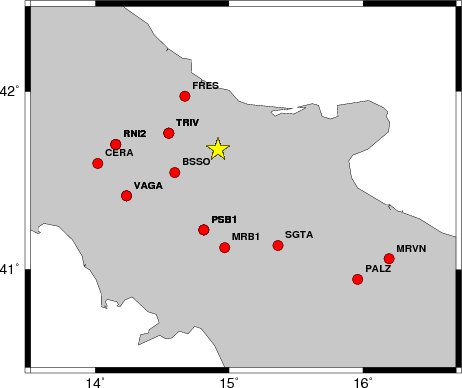
2011/04/04 13:11:51 41.675 14.918 19.5 3.3 Italy
USGS Felt map for this earthquake
USGS/SLU Moment Tensor Solution
ENS 2011/04/04 13:11:51:0 41.67 14.92 19.5 3.3 Italy
Stations used:
IV.BSSO IV.CERA IV.FRES IV.MRB1 IV.MRVN IV.PALZ IV.PSB1
IV.RNI2 IV.SGTA IV.TRIV IV.VAGA
Filtering commands used:
hp c 0.02 n 3
lp c 0.10 n 3
br c 0.12 0.25 n 4 p 2
Best Fitting Double Couple
Mo = 1.33e+21 dyne-cm
Mw = 3.35
Z = 14 km
Plane Strike Dip Rake
NP1 267 71 -159
NP2 170 70 -20
Principal Axes:
Axis Value Plunge Azimuth
T 1.33e+21 1 38
N 0.00e+00 62 307
P -1.33e+21 28 129
Moment Tensor: (dyne-cm)
Component Value
Mxx 4.12e+20
Mxy 1.16e+21
Mxz 3.61e+20
Myy -1.18e+20
Myz -4.19e+20
Mzz -2.93e+20
---###########
------################
---------################# T
----------#################
-----------#######################
------------########################
-------------#########################
--------------##########################
--------------####----------############
--------#######-----------------------####
----############--------------------------
################--------------------------
################--------------------------
################------------------------
################------------------------
################------------- ------
###############------------- P -----
###############------------ ----
##############----------------
##############--------------
############----------
##########----
Global CMT Convention Moment Tensor:
R T P
-2.93e+20 3.61e+20 4.19e+20
3.61e+20 4.12e+20 -1.16e+21
4.19e+20 -1.16e+21 -1.18e+20
Details of the solution is found at
http://www.eas.slu.edu/eqc/eqc_mt/MECH.IT/20110404131151/index.html
|
STK = 170
DIP = 70
RAKE = -20
MW = 3.35
HS = 14.0
The waveform inversion is preferred.
The following compares this source inversion to others
USGS/SLU Moment Tensor Solution
ENS 2011/04/04 13:11:51:0 41.67 14.92 19.5 3.3 Italy
Stations used:
IV.BSSO IV.CERA IV.FRES IV.MRB1 IV.MRVN IV.PALZ IV.PSB1
IV.RNI2 IV.SGTA IV.TRIV IV.VAGA
Filtering commands used:
hp c 0.02 n 3
lp c 0.10 n 3
br c 0.12 0.25 n 4 p 2
Best Fitting Double Couple
Mo = 1.33e+21 dyne-cm
Mw = 3.35
Z = 14 km
Plane Strike Dip Rake
NP1 267 71 -159
NP2 170 70 -20
Principal Axes:
Axis Value Plunge Azimuth
T 1.33e+21 1 38
N 0.00e+00 62 307
P -1.33e+21 28 129
Moment Tensor: (dyne-cm)
Component Value
Mxx 4.12e+20
Mxy 1.16e+21
Mxz 3.61e+20
Myy -1.18e+20
Myz -4.19e+20
Mzz -2.93e+20
---###########
------################
---------################# T
----------#################
-----------#######################
------------########################
-------------#########################
--------------##########################
--------------####----------############
--------#######-----------------------####
----############--------------------------
################--------------------------
################--------------------------
################------------------------
################------------------------
################------------- ------
###############------------- P -----
###############------------ ----
##############----------------
##############--------------
############----------
##########----
Global CMT Convention Moment Tensor:
R T P
-2.93e+20 3.61e+20 4.19e+20
3.61e+20 4.12e+20 -1.16e+21
4.19e+20 -1.16e+21 -1.18e+20
Details of the solution is found at
http://www.eas.slu.edu/eqc/eqc_mt/MECH.IT/20110404131151/index.html
|
The focal mechanism was determined using broadband seismic waveforms. The location of the event and the and stations used for the waveform inversion are shown in the next figure.

|
|
|
The program wvfgrd96 was used with good traces observed at short distance to determine the focal mechanism, depth and seismic moment. This technique requires a high quality signal and well determined velocity model for the Green functions. To the extent that these are the quality data, this type of mechanism should be preferred over the radiation pattern technique which requires the separate step of defining the pressure and tension quadrants and the correct strike.
The observed and predicted traces are filtered using the following gsac commands:
hp c 0.02 n 3 lp c 0.10 n 3 br c 0.12 0.25 n 4 p 2The results of this grid search from 0.5 to 19 km depth are as follow:
DEPTH STK DIP RAKE MW FIT
WVFGRD96 1.0 15 55 55 3.10 0.2231
WVFGRD96 2.0 0 70 35 3.15 0.2647
WVFGRD96 3.0 170 75 -20 3.18 0.3014
WVFGRD96 4.0 165 65 -25 3.24 0.3537
WVFGRD96 5.0 165 65 -30 3.30 0.3785
WVFGRD96 6.0 165 65 -30 3.31 0.4019
WVFGRD96 7.0 165 60 -25 3.33 0.4160
WVFGRD96 8.0 165 65 -25 3.31 0.4290
WVFGRD96 9.0 165 65 -25 3.32 0.4345
WVFGRD96 10.0 165 65 -25 3.32 0.4373
WVFGRD96 11.0 165 65 -25 3.33 0.4388
WVFGRD96 12.0 170 70 -20 3.34 0.4401
WVFGRD96 13.0 170 70 -20 3.35 0.4407
WVFGRD96 14.0 170 70 -20 3.35 0.4421
WVFGRD96 15.0 165 65 -25 3.37 0.4386
WVFGRD96 16.0 165 65 -25 3.37 0.4377
WVFGRD96 17.0 170 70 -25 3.39 0.4358
WVFGRD96 18.0 170 70 -25 3.40 0.4332
WVFGRD96 19.0 170 70 -25 3.40 0.4299
WVFGRD96 20.0 170 70 -25 3.41 0.4267
WVFGRD96 21.0 125 60 -5 3.40 0.4247
WVFGRD96 22.0 125 60 -5 3.41 0.4226
WVFGRD96 23.0 120 55 -10 3.42 0.4200
WVFGRD96 24.0 120 55 -10 3.43 0.4168
WVFGRD96 25.0 120 55 -10 3.44 0.4129
WVFGRD96 26.0 120 55 -10 3.45 0.4081
WVFGRD96 27.0 120 55 -10 3.46 0.4021
WVFGRD96 28.0 120 55 -10 3.47 0.3963
WVFGRD96 29.0 170 60 -30 3.49 0.3914
The best solution is
WVFGRD96 14.0 170 70 -20 3.35 0.4421
The mechanism correspond to the best fit is
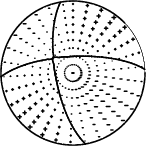
|
|
|
The best fit as a function of depth is given in the following figure:
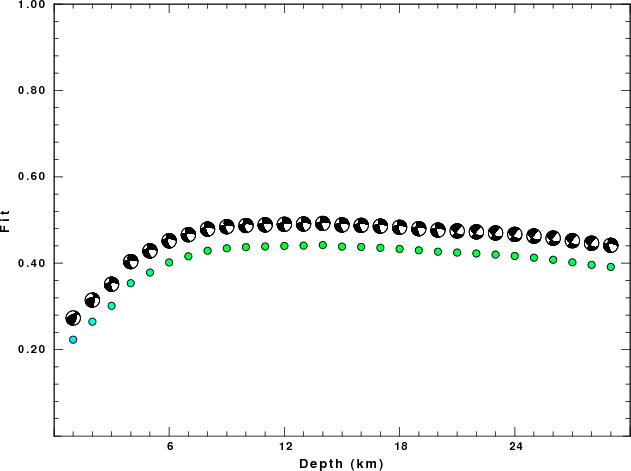
|
|
|
The comparison of the observed and predicted waveforms is given in the next figure. The red traces are the observed and the blue are the predicted. Each observed-predicted component is plotted to the same scale and peak amplitudes are indicated by the numbers to the left of each trace. A pair of numbers is given in black at the right of each predicted traces. The upper number it the time shift required for maximum correlation between the observed and predicted traces. This time shift is required because the synthetics are not computed at exactly the same distance as the observed and because the velocity model used in the predictions may not be perfect. A positive time shift indicates that the prediction is too fast and should be delayed to match the observed trace (shift to the right in this figure). A negative value indicates that the prediction is too slow. The lower number gives the percentage of variance reduction to characterize the individual goodness of fit (100% indicates a perfect fit).
The bandpass filter used in the processing and for the display was
hp c 0.02 n 3 lp c 0.10 n 3 br c 0.12 0.25 n 4 p 2
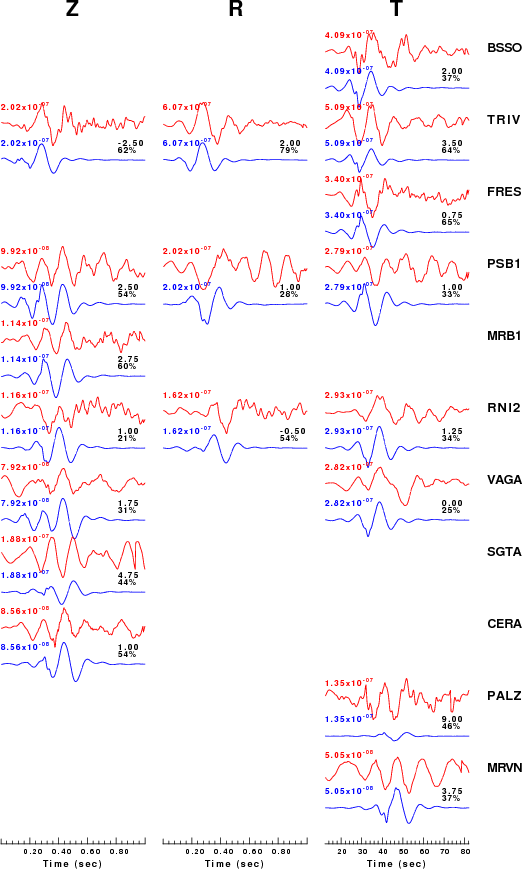
|
|
|
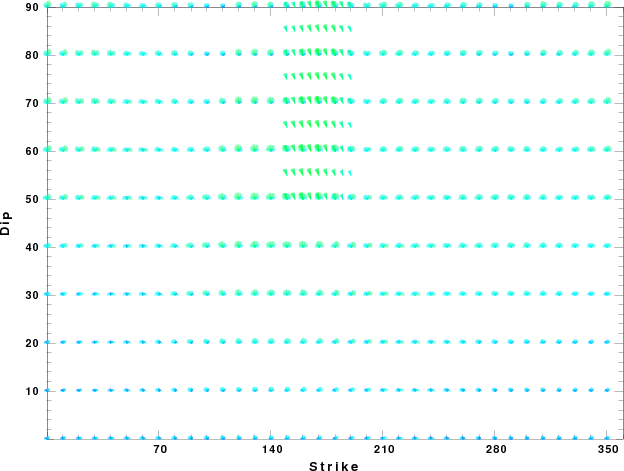
|
| Focal mechanism sensitivity at the preferred depth. The red color indicates a very good fit to thewavefroms. Each solution is plotted as a vector at a given value of strike and dip with the angle of the vector representing the rake angle, measured, with respect to the upward vertical (N) in the figure. |
A check on the assumed source location is possible by looking at the time shifts between the observed and predicted traces. The time shifts for waveform matching arise for several reasons:
Time_shift = A + B cos Azimuth + C Sin Azimuth
The time shifts for this inversion lead to the next figure:
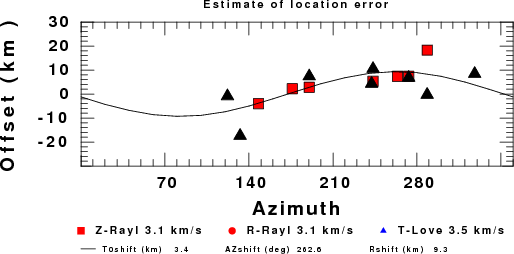
The derived shift in origin time and epicentral coordinates are given at the bottom of the figure.
The nnCIA used for the waveform synthetic seismograms and for the surface wave eigenfunctions and dispersion is as follows:
MODEL.01
C.It. A. Di Luzio et al Earth Plan Lettrs 280 (2009) 1-12 Fig 5. 7-8 MODEL/SURF3
ISOTROPIC
KGS
FLAT EARTH
1-D
CONSTANT VELOCITY
LINE08
LINE09
LINE10
LINE11
H(KM) VP(KM/S) VS(KM/S) RHO(GM/CC) QP QS ETAP ETAS FREFP FREFS
1.5000 3.7497 2.1436 2.2753 0.500E-02 0.100E-01 0.00 0.00 1.00 1.00
3.0000 4.9399 2.8210 2.4858 0.500E-02 0.100E-01 0.00 0.00 1.00 1.00
3.0000 6.0129 3.4336 2.7058 0.500E-02 0.100E-01 0.00 0.00 1.00 1.00
7.0000 5.5516 3.1475 2.6093 0.167E-02 0.333E-02 0.00 0.00 1.00 1.00
15.0000 5.8805 3.3583 2.6770 0.167E-02 0.333E-02 0.00 0.00 1.00 1.00
6.0000 7.1059 4.0081 3.0002 0.167E-02 0.333E-02 0.00 0.00 1.00 1.00
8.0000 7.1000 3.9864 3.0120 0.167E-02 0.333E-02 0.00 0.00 1.00 1.00
0.0000 7.9000 4.4036 3.2760 0.167E-02 0.333E-02 0.00 0.00 1.00 1.00
Here we tabulate the reasons for not using certain digital data sets
The following stations did not have a valid response files:
DATE=Sat Apr 9 15:52:01 CDT 2011